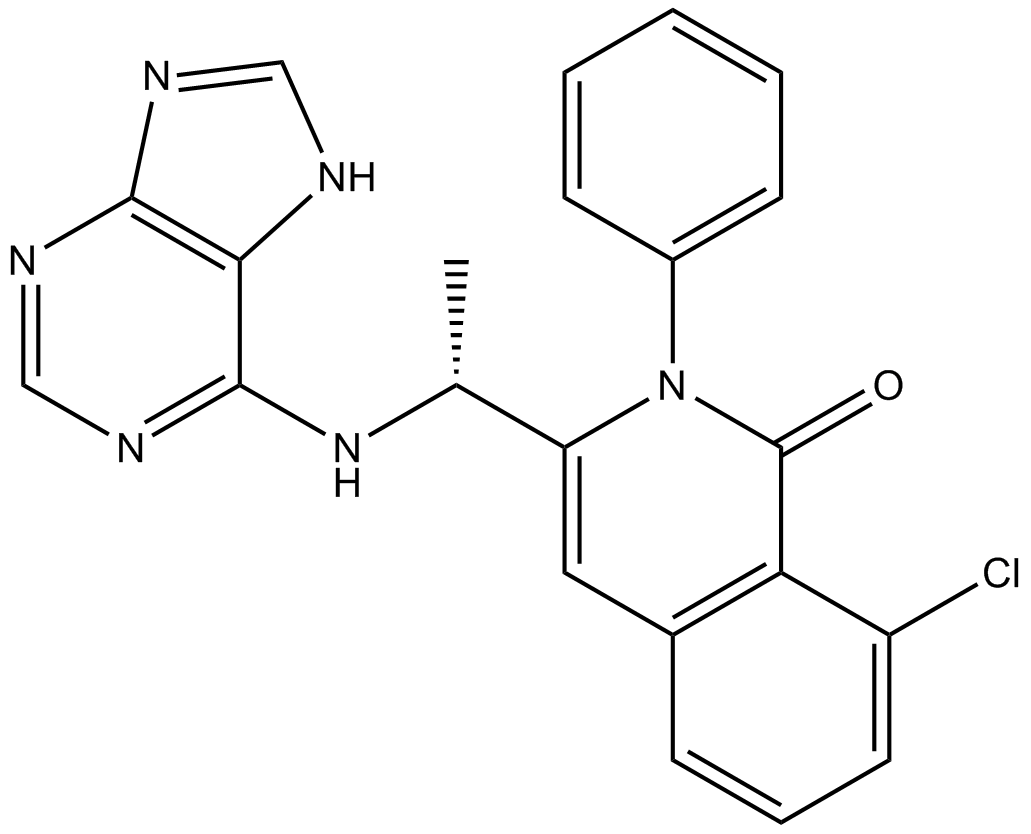IPI-145 (INK1197) (Synonyms: Duvelisib, INK1197) |
| Catalog No.GC10749 |
IPI-145 (INK1197) (IPI-145) is a selectivite p100δ inhibitor with IC50 of 2.5 nM, 27.4 nM, 85 nM and 1602 nM for p110δ, P110γ, p110β and p110α, respectively.
Products are for research use only. Not for human use. We do not sell to patients.

Cas No.: 1201438-56-3
Sample solution is provided at 25 µL, 10mM.
IPI-145 (also known as INK1197), an isoquinolinone derivative, is a small-molecule phosphoinositide-3 kinases (PI3K) inhibitor that selectively and potently inhibits two PI3K isoforms, PI3K-δ and PI3K-γ, with half maximal inhibition concentration IC50 of 2.5 nM and 27 nM respectively. Despite of preference for PI3K-δ and PI3K-γ, IPI-145 also inhibits other PI3K isoforms, PI3K-α and PI3K-β, to a lesser extent with IC50 of 1602 nM and 85 nM respectively.
Due to the essential role of PI3K-δ in the proliferation of B cell and T cell, IPI-145 exhibits potent anti-proliferative activity against both cells with IC50 of 0.5 nM and 9.5 nM respectively leading to inhibition of neutrophil migration and basophil activation.
Inhibition of immune function through IPI-145-induced PI3K-δ and PI3K-γ blockade potentiates its application in the treatment of multiple inflammatory, autoimmune and hematologic diseases.
References:
[1] Winkler DG1, Faia KL, DiNitto JP, Ali JA, White KF, Brophy EE, Pink MM, Proctor JL, Lussier J, Martin CM, Hoyt JG, Tillotson B, Murphy EL, Lim AR, Thomas BD, Macdougall JR, Ren P, Liu Y, Li LS, Jessen KA, Fritz CC, Dunbar JL, Porter JR, Rommel C, Palombella VJ, Changelian PS, Kutok JL. PI3K-δ and PI3K-γ inhibition by IPI-145 abrogates immune responses and suppresses activity in autoimmune and inflammatory disease models. Chem Biol. 2013 Nov 21;20(11):1364-74. doi: 10.1016/j.chembiol.2013.09.017. Epub 2013 Nov 7.
Average Rating: 5 (Based on Reviews and 26 reference(s) in Google Scholar.)
GLPBIO products are for RESEARCH USE ONLY. Please make sure your review or question is research based.
Required fields are marked with *




















